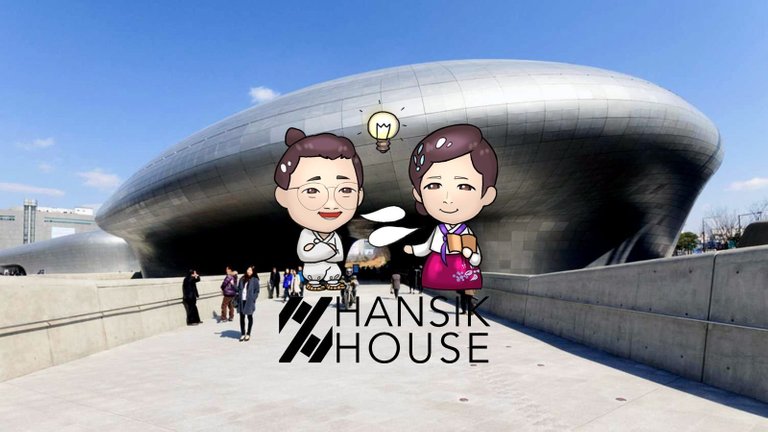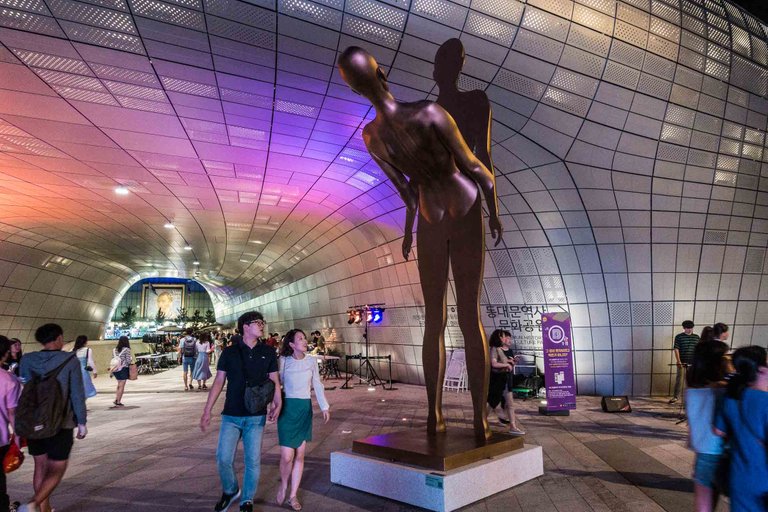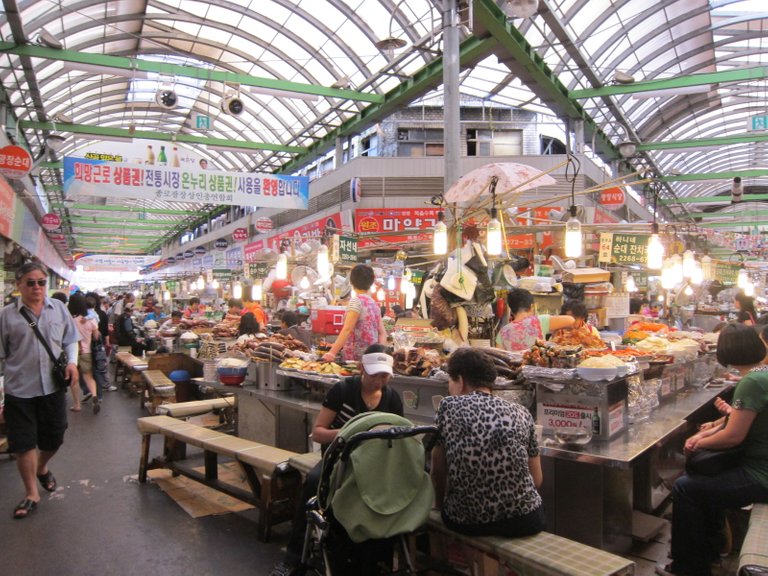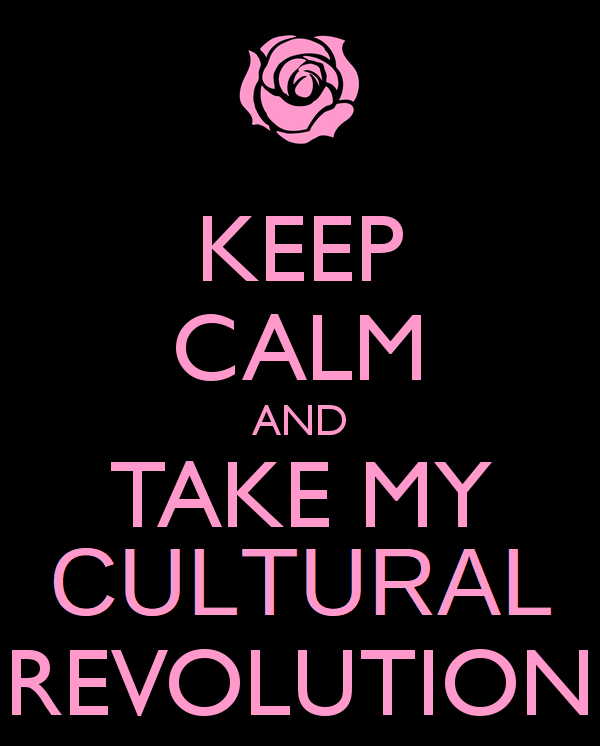
Yesterday, I began to explain the conundrum of Korean cities. Korea has recently been striving for cultural actualization and establishing the biggest cities as premiere tourist destinations. The Dongdaemun Design Plaza (DDP) is an ideal case-study of this attitude's efficacy in the modern world.
Urban Bling
The Design Plaza is a beautiful shell and pretty much just that in all other aspects, a shell. Despite ambitions to raise Korea's urban value to the world and over the next cultural hotspot, the project really had no meat to it. There were no nurtured institutional links or programs to meet the project's expectations. There were no foundations or institutions tasked with keeping it vibrant and engaged. The Dongdaemun Design Plaza, originally tasked to be the most innovative and diverse nexus of East Asia has become little more than a rentable convention center.

Source: My Korean Diaries
Even today, the building and complex stands partially, sometimes even mostly empty. Every so often there will be a short traveling exhibition or conference by big name brands, but very few recurring and almost nothing in-house. The project hemorrhages state funds and more focus is put keeping it afloat than anything remotely innovative. This consequently has an enormous influence on the nature and viability of ongoing programs, opting for big-budget commercially-driven events. As it stands, the project is a city ornament.
Though, this isn't to say that any other cultural institutions around the world are much different in the financial respect. Every version of a city MoMa, each public collection or state library, and all franchises of the Guggenheim are fundamentally not profit-makers. What helps them stay afloat and sustain innovation-driven programs is not (only) the characteristics of the building, but the robust and forward-planning donor, grant, and other engaged support efforts.
A Need to Plan a Cultural Revolution
As they stand now, cultural destinations in Korea either require massive state funding (i.e. the National Korea Museum) or deep deep pockets (i.e. the Leeum collection/museum). In a country where charity and donorship are still an underdeveloped facet of society, all grand-scale creative ambitions rely on these two.

Source: Travel Assets
One of the main weaknesses is the assumption that the building itself would embody success. It is magnificent, no doubt, and a metallic magnet for anyone disembarking from Incheon airport for the first time. Of course it would attract eyeballs and seduce all the premiere makers of the world. But a piece of infrastructure, especially one solely reliant on ephemeral creative activity, can never operate on an island no matter how impressive. The making of the building stimulated a number of design foundations and institutions to start, but without a robust base of existing activity, the design plaza adds onto the cultural tangle of Korea rather than navigate it. Korean cultural infrastructure is stuck in the chicken-and-egg conundrum and the DDP attempted poorly to be an over-invested shell.

Source: Travel Past
Grassroots Vibrancy
Back to the superficial nature of Korean society. It is without question that mainstream Korean society spends more effort on appearance and specs over substantive content and self-actualization. This means that the pristine roads of Korea will always be filled with expensive foreign cars and citizens draped in high fashion. We see this attitude scale up as well and Seoul has witnessed developments such as the Dongdaemun Design Plaza and Lotte Tower in the past decade. Visually, they are stunning. Internally, they are barren.
There is no escaping a stamp of a social attitude on built form and program. Korea's social fabric is oriented to produce individuals of high creative value, instead historically leaning towards group-thing and action. If the future of Korea's cultural identity will partially depend on these moments of infrastructural wonder, a rewoven fabric is needed to support the resonance of these place.

Source: NeneJoayo
In my opinion, design has typically little to do with dictating an outcome. I say this as a trained architect and designer, knowing full well that intentions and aesthetics do not ensure a certain usage. The vibrancy of the New York MoMA or the London Tate is absolutely supported by its visual iconicism, but that precise quality that Korea envies emerges from an underlying dynamism and entrepreneurial spirit that fizzles on Korean ground.
Anyway, there's a bit to unpack so let me know your thoughts below!

I think that the DDP should have drawn more from the surrounding area. It's smack dab in the middle of the fashion center of Seoul and yet the amount of fashion events it holds are very few. It should have been a place where small businesses could show off their new styles and fashions. Being used as a way to promote Korean fashion to both travelers and locals. Instead as you said it is mostly empty.
That's a great idea @atlantictech and speaks to a problematic attitude that Korean administrations have of "go big or go home." There are thousands of young talented designers in the immediate area and because of the unsustainability of the project, the institution has to focus on big-budget big-brand projects.
nice post @hansikhouse
Thanks for reading @hasida420!
I would say that this kind of problem isn't limited just to Korea.
Oh well
Oh of course not! This is just a case-study in what happens in many many other places.
the originality gets lost.
I think Korean administrators conflate originality with big-brand design.
Thanks for the comment @mintvilla!
Lovely post! Very interesting for me especially right now, as I landed in Seoul yesterday 😊
Whoa very cool! Enjoy your stay!
Thanks, will definitely do :)
This is a plight that occurs in many places around the world. Wonderful architecture but little to support it i way of culture, We have a beautiful theatre that sits empty most of the year. It is such a shame.
It is definitely a systemic problem. Do you mind me asking which city you live in @cecicastor?
I am living on the beach in Nicaragua. The theatre I am referring too is the one in Leon. It is old but so beautiful. Sits empty most of the time.